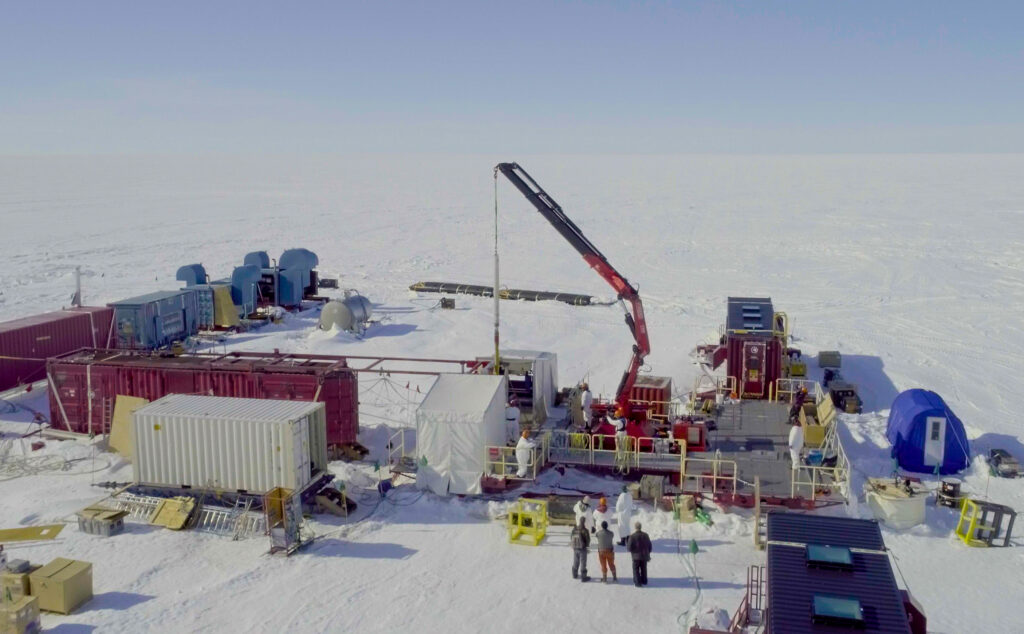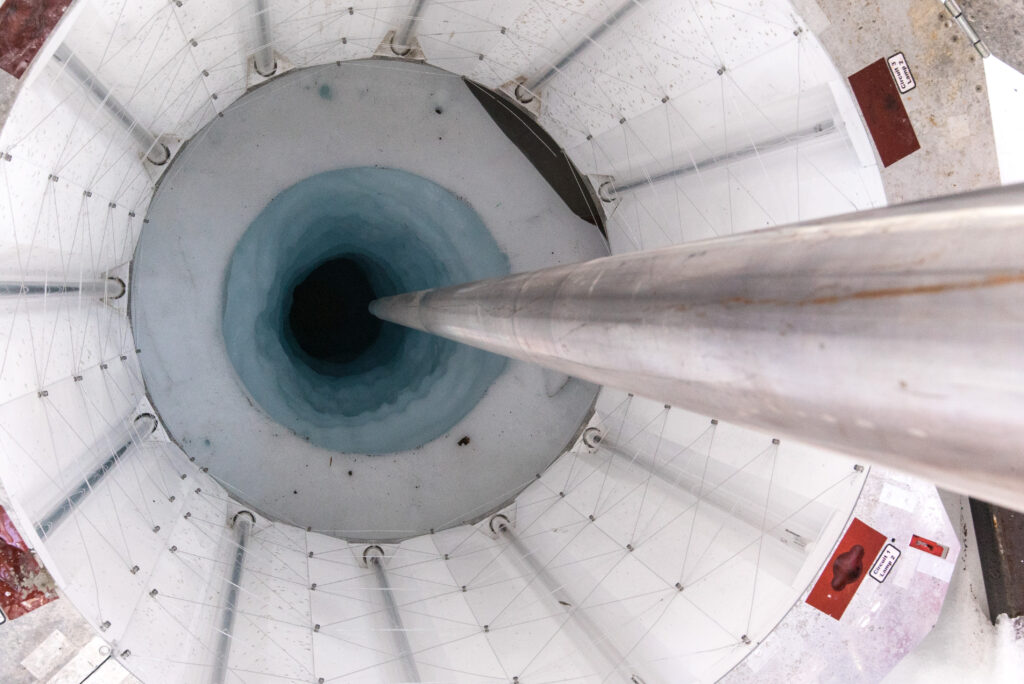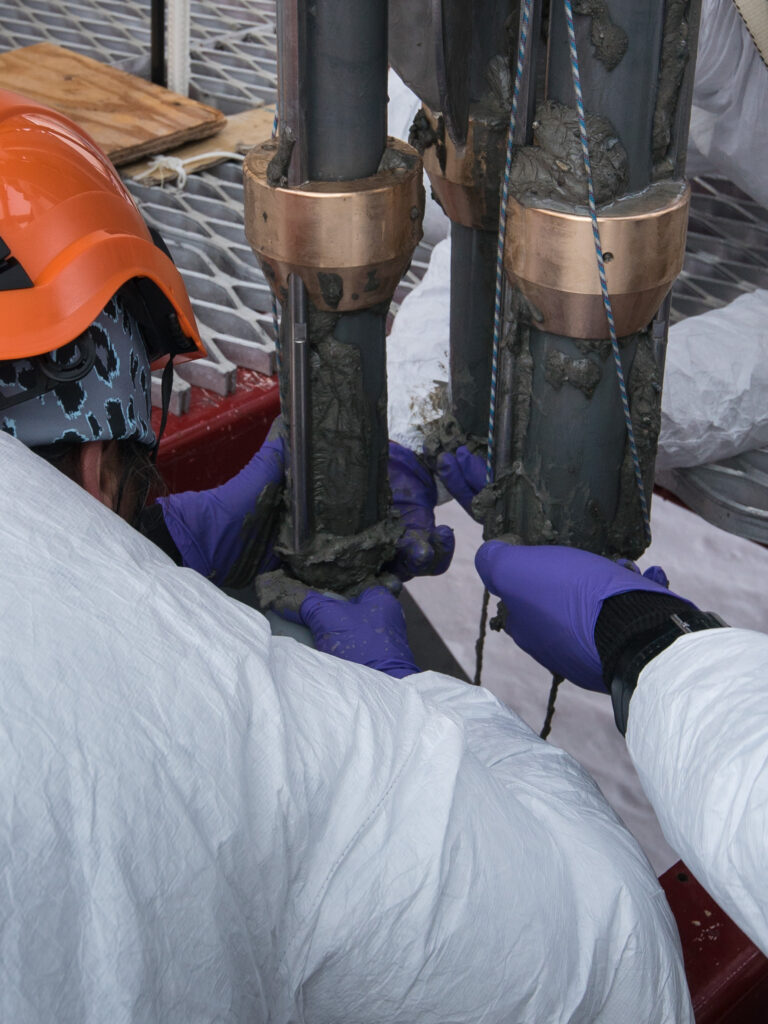
The West Antarctic Ice Sheet retreated at least 250 kilometers (160 miles) inland of where the ice meets the ocean today, then re-advanced, according to new research published in AGU Advances. Scientists traced the ice's movement using sediments from a lake more than 1 kilometer (0.6 miles) under the ice, sampled using the corer in this photo. Credit: Billy Collins

To reach the subglacial lake, the team drilled through the ice with hot water and UV-sterilized equipment. Credit: Billy Collins
Because radiocarbon (carbon-14) in these sediments must have come from seawater, the finding suggests that what is now

Carbon in sediments from the lake, which has been sealed off from the atmosphere for thousands of years, revealed when the ice retreated and then advanced. Credit: Billy Collins
a lake 150 kilometers (93 miles) from the modern ice edge was the floor of the ocean. When the ice advanced, it capped off the lake, preserving the carbon as part of the lake bottom's sediments. And based on radiocarbon in water sampled from the same lake, the grounding line could have been 100 kilometers (62 miles) even farther inland at that time.
"When we set out to sample this lake, we weren't sure what we would find out about ice history, but the fact that deglaciation persisted this far inland was not that wild of a possibility," Venturelli said. "This area of West Antarctica is really flat. There is nothing to put brakes on the retreat of the grounding line. No real topographical doorstops."
The new evidence of Antarctic ice's ability to make a comeback was welcome news for Venturelli.
"It can be a bummer sometimes, studying ice loss in Antarctica," Venturelli said. "Although the re-advance identified in the geologic record happens over thousands of years, I like to think of studying the process of reversibility as a little shred of hope."
The next big question for Venturelli and her coauthors is assessing what conditions enabled the ice's re-advance. One possibility is the rebound after release from the massive weight of the ice sheet lifted the land enough to hold back the ocean and allow the ice to regrow. Another possibility is that slight changes in climate enabled the ice sheet to switch from retreat to advance. It could have been a combination of these influences.
#
AGU (www.agu.org) is a global community supporting more than half a million advocates and professionals in Earth and space sciences. Through broad and inclusive partnerships, AGU aims to advance discovery and solution science that accelerate knowledge and create solutions that are ethical, unbiased and respectful of communities and their values. Our programs include serving as a scholarly publisher, convening virtual and in-person events and providing career support. We live our values in everything we do, such as our net zero energy renovated building in Washington, D.C. and our Ethics and Equity Center, which fosters a diverse and inclusive geoscience community to ensure responsible conduct.
Notes for journalists:
This study is published in AGU Advances, a fully open-access journal. View and download a pdf of the study here.
Additional media accompanying this story are available at request from the study author. The SALSA team also produced a documentary related to the study; video footage may be available on request from the SALSA team.
Paper title:
"Constraints on the Timing and Extent of Deglacial Grounding Line Retreat in West Antarctica"
Authors:
- Ryan A. Venturelli (corresponding author), Matthew R. Siegfried, Colorado School of Mines, Golden, CO, USA
- Brenna Boehman, Valier Galy, Woods Hole Oceanographic Institution, Woods Hole, MA, USA
- Christina Davis, Brent C. Christner, University of Florida, Gainesville, FL, USA
- Jon R. Hawkings, University of Pennsylvania, Philadelphia, PA, USA
- Sarah E. Johnston, University of Alaska Fairbanks, Fairbanks, AK, USA
- Chloe D. Gustafson, Cyrille Mosbeux, Helen A. Fricker, Scripps Institution of Oceanography, La Jolla, CA, USA
- Alexander B. Michaud, Bigelow Laboratory for Ocean Sciences, East Boothbay, ME, USA
- Trista J. Vick-Majors, Michigan Technological University, Houghton, MI, USA
- Robert G. M. Spencer, Florida State University, Tallahassee, FL, USA
- Sophie Warny, Louisiana State University, Baton Rouge, LA, USA
- David M. Harwood, University of Nebraska-Lincoln, Lincoln, NE, USA
- Amy Leventer, Colgate University, Hamilton, NY, USA
- John C. Priscu, Polar Oceans Research Group, Sheridan, MT, USA
- Brad E. Rosenheim, College of Marine Science, University of South Florida, St. Petersburg, FL, USA
- The SALSA Science Team






